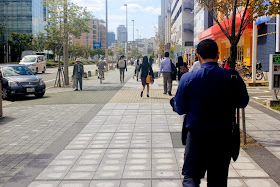The days of lecture started quickly as if to
remind us that we came to the land of the rising sun to learn and not just to
tour around. Just like the autumn season, we counted the hours of lessons in
our fingers as they fall in our eager ears. Let me give my top 5 early realizations from the lectures of Japanese officials, economists, bankers, and business people:
1. "Stakeholder Capitalism" vs.
"Stockholder Capitalism" - Although this was highlighted by
Odano-sensei of Shiga University. This became more evident in the lectures of
economists of the province. Stakeholder capitalism promotes passion and
dedication of work as one will be deeply immersed in an organization. The
respect for seniority, and 'oneness' of goal, is only the basic element of such
kind of economic structure, unlike the 'stockholder capitalism' of the west
(which has been adopted by our country) which gives more value on the upper
management and 'stockholders' or owners of organizations and companies. (I will
dedicate another blog article for this to explain further).
2. Partnerships and Linkages are needed formula
to success. - There is no hero in Japan because everyone is a hero in their own
work and duties, they call this “Kiba”. In fact, their regard for calling
cards, and the exchange thereof, are symbolic of their value towards
partnerships, coordination, and participation.
 |
| My classmates with one of the lecturers |
3. Discipline. - Because of their 'oneness',
their thoughts are always for their country. "If I throw my garbage here,
the place will look dirty and I don't want my country to look dirty",
"If I disobey traffic laws, somebody might suffer because of my
recklessness, I don't want a countryman to suffer because of my untoward
actions." In the Philippines? Nahhh...
4. Honor – This is a typical Japanese way. In the
lecture by the officers of Iyo bank, they explained the importance of rendering
loans for business start-ups at zero-percent interest rate. When I asked them
about what happens upon default when the borrower fails to return the loaned
money? The officer, to my deep embarrassment said, “Japanese people will always
return what they owe. If their business fails, they will find other ways to
return it, even though it will take a lifetime to do so..” Perhaps that is why
even in their business structure, one does not obtain a crucial position if
he/she doesn’t have the skills to do the job - it means that ‘one only eats
what he/she can swallow’. Because when that person fails in that job, the 100th
floor window will openly welcome the ‘dishonored’.
 |
| The Sake Boys: (from left; Lucky, Mark, Me, Jamz, Migz, Regin) |
5. Passion - Their passion for their work were perhaps reinforced by their rebuilder generation (the generation after the war who vowed to rebuild Japan from its ruins). With such attitude, all of the people work, not primarily for money, but to become the best of what they do - regardless if one is a maintenance worker, bus driver, teacher, or government official, as long as they are the best. (Photo on the side is taken during our courtesy call to the Ehime Governor's office. Their government office is so passionate about their tourism identity and goods. I will have a separate article about their OTOP promotion and marketing).
_______________________________________________________________________________
We were relieved and excited that we will have at least a couple of days away from the 'classroom' to visit the coastal towns of Omishima Islands and Imabari. When Maro-san boarded the bus, he, just like any great tour guide would, presented a very good theme for our trip:
"Don't think...feel" (By Bruce Lee) :)
"Today's theme is, Don't think...Feel.. by Bruce Lee.." So, for this part...I'll stop my musings and perhaps, just relive the memorable moments I had on the Islands. (Below are some of our Pictures)
 |
| Great guys! |
 |
| I'll miss these guys.. |
 |
| Story telling time to Iwanaga Shrine |
 |
| Every space along the way were transformed to parks |
 |
| Oyamazumi Shrine |
 |
| Imabari Castle, Imabari City |
 |
| Itadakemasu! |
 |
| Biking in the bridge |
"Don't think...feel"
Click link for Part 1 ---------> Japan experience (Part 1 of 5)
Click link for Part 2----------> Japan Experience (Part 2 of 5)
Click link for Part 3---------->Japan Experience (Part 4 of 5)
Click link for Part 2----------> Japan Experience (Part 2 of 5)
Click link for Part 3---------->Japan Experience (Part 4 of 5)















